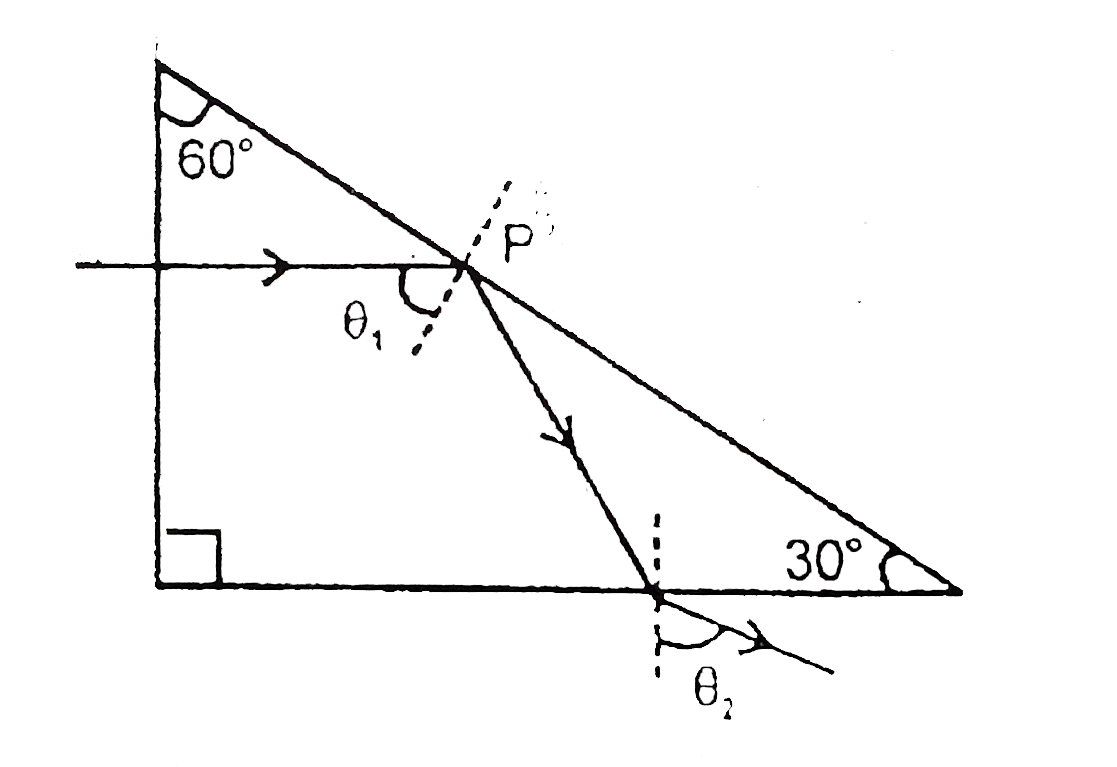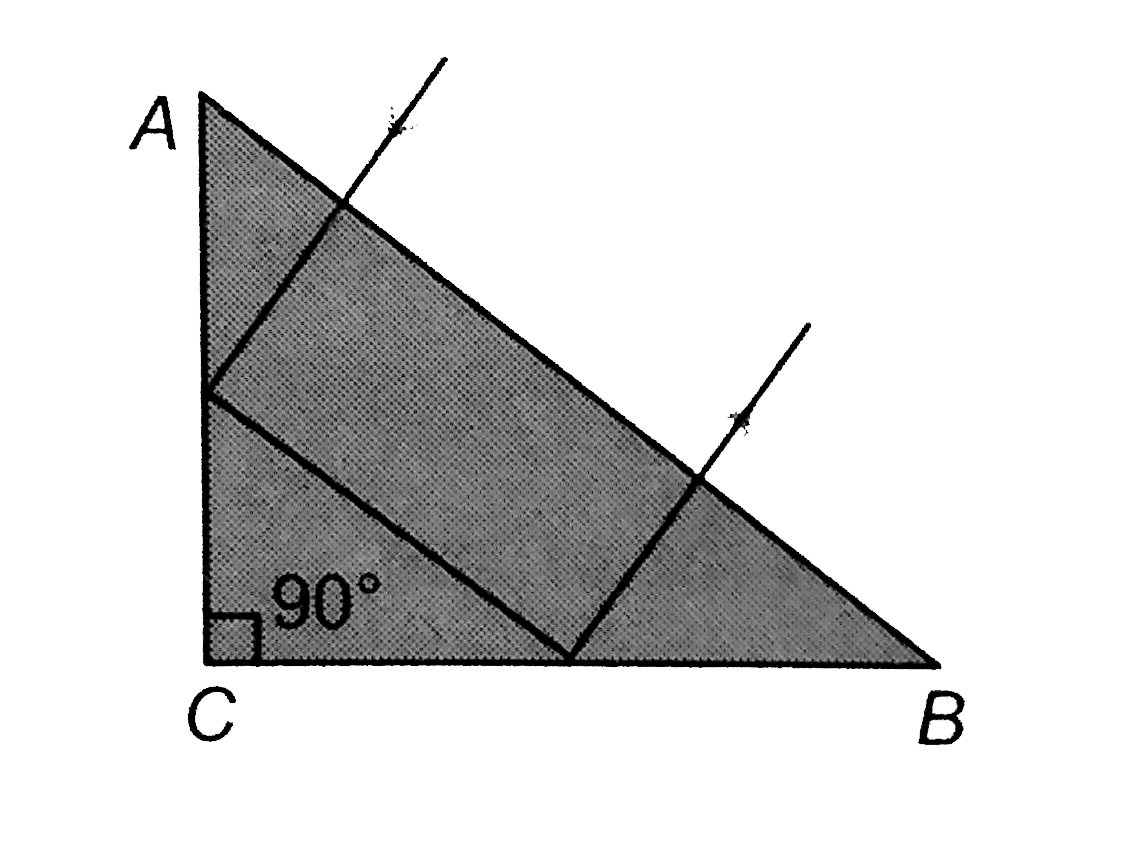A ray of light is incident normally on one face of a right-angled isosceles prism and then it grazes the hypotenuse. The refractive index of the material of the prism is
1.33
1.414
1.5
1.732
The correct Answer is:B
To solve the problem of finding the refractive index of a right-angled isosceles prism when a ray of light is incident normally on one face and grazes the hypotenuse, we can follow these steps:
1. Understanding the Geometry of the Prism:
- The prism is a right-angled isosceles prism, which means it has one right angle (90 degrees) and the other two angles are equal (45 degrees each).
- Let’s denote the angles: angle A = 90°, angle B = 45°, angle C = 45°.
2. Incident Ray:
- A ray of light is incident normally on one of the faces of the prism. Since it is incident normally, the angle of incidence (i) at this face is 0°.
- Therefore, the ray passes straight through without bending.
3. Refraction at the Hypotenuse:
- The ray then reaches the hypotenuse of the prism. At this point, it will refract according to Snell's Law.
- Since the ray grazes the hypotenuse, it means that the angle of incidence at the hypotenuse is equal to 90° (the ray is at the critical angle).
4. Applying Snell's Law:
- Snell's Law states:
n1sin(i)=n2sin(r)
- Here, n1 is the refractive index of the prism (let's denote it as μ), n2 is the refractive index of air (which is approximately 1), i is the angle of incidence (which we found to be 45°), and r is the angle of refraction (which is 90° since the ray grazes the hypotenuse).
5. Substituting Values:
- From Snell's Law, we have:
μsin(45°)=1sin(90°)
- We know that sin(90°)=1 and sin(45°)=1√2.
6. Solving for the Refractive Index:
- Substituting these values into the equation gives:
μ⋅1√2=1⋅1
- Rearranging this gives:
μ=√2
7. Final Answer:
- The refractive index of the material of the prism is √2 or approximately 1.414.
- The prism is a right-angled isosceles prism, which means it has one right angle (90 degrees) and the other two angles are equal (45 degrees each).
- Let’s denote the angles: angle A = 90°, angle B = 45°, angle C = 45°.
- A ray of light is incident normally on one of the faces of the prism. Since it is incident normally, the angle of incidence (i) at this face is 0°.
- Therefore, the ray passes straight through without bending.
- The ray then reaches the hypotenuse of the prism. At this point, it will refract according to Snell's Law.
- Since the ray grazes the hypotenuse, it means that the angle of incidence at the hypotenuse is equal to 90° (the ray is at the critical angle).
- Snell's Law states:
n1sin(i)=n2sin(r)
- Here, n1 is the refractive index of the prism (let's denote it as μ), n2 is the refractive index of air (which is approximately 1), i is the angle of incidence (which we found to be 45°), and r is the angle of refraction (which is 90° since the ray grazes the hypotenuse).
- From Snell's Law, we have:
μsin(45°)=1sin(90°)
- We know that sin(90°)=1 and sin(45°)=1√2.
- Substituting these values into the equation gives:
μ⋅1√2=1⋅1
- Rearranging this gives:
μ=√2
- The refractive index of the material of the prism is √2 or approximately 1.414.
Topper's Solved these Questions
Similar Questions
A ray of light normally on one of the faces of a right-angled isosceles glass prism is found to be totally reflected. What is the minimum value of the refractive index of the material of the prism ?
View SolutionA ray incident normally on one face of a right-angled isosceles glass prism in air is deviated through 90∘. What can you say about the refractive index of glass ?
View Solution
Knowledge Check

A ray of light is incident normally on one face of a prism as shown in figure. The refractive index of the material of the prism is 53 and the prism is immersed in water of refractive index 43, thenAThe angle of emergence θ2 of the ray is sin−2(58)BThe angle of emergence θ2 of the ray is sin−1(54√3)CThe angle of emerrgence θ2 of the ray is sin−1(73√4)DTotal internal reflection will not occur at P if the refractive index of water increases to a value greater than 52√3 by dissolving some substance.A ray of light incident normally on an isosceles right angled prism travels as shown in the figure. The least value of the refractive index of the prism must be
 A√2B√3C1.5D2.0
A√2B√3C1.5D2.0A ray of light is incident at an angle of 60∘ on the face of a prism with an angle of 60∘. Then the refractive index of the material of the prism is (the prism is in minimum deviation position)
A1.414B1.623C1.524D1.732
A ray of light is incident at 60∘ on one face of a prism of angle 30∘ and the emergent ray makes 30∘ with the incident ray. The refractive index of the prism is
View SolutionA monochromatic ray of light is incident normally on one of the refracting surfaces of a prism . The emergent ray grazes the second refracting surface . What is the angle of the prism if the refractive index of the material of the prism is 1.6 ?
View SolutionA ray of light is incident at 65∘ on one face of a prism of angle of 30∘ and the emergent ray makes 35∘ with the incident ray. The refractive index of the prism is:
View SolutionA ray of light is incident at an angle of incidence 45∘ on an equilateral prism and emerge at an angle 45∘ then the refractive index of the medium of the prism is:
View SolutionA ray of light is incident normally on one of the equal faces of a right isosceles prism of refractive index 1.5. The angle between incident and emergent rays is
View Solution
